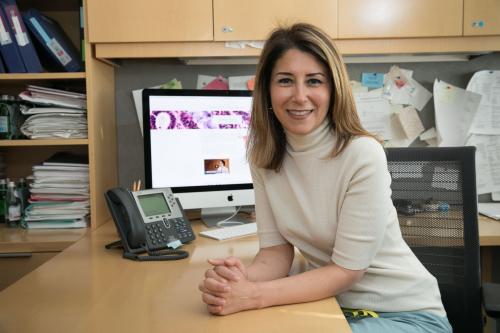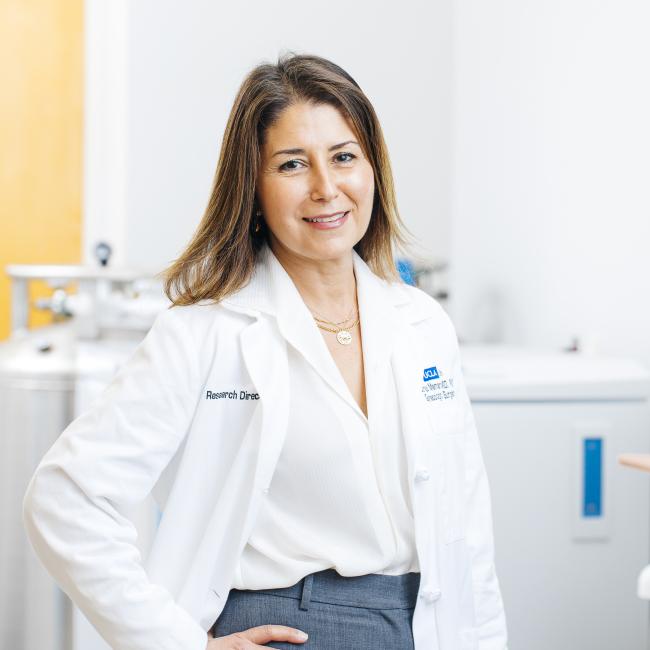
Dr. Sanaz Memarzadeh: An Early Passion for Research
Growing up in a family of physicians, Dr. Sanaz Memarzadeh was curious about science from an early age. While she eventually pursued medicine as a career, she remained interested in basic science throughout her medical training.
During medical school, Dr. Memarzadeh decided to devote her clinical practice to women with gynecologic cancers. Early in her three-year gynecologic oncology fellowship, she realized that women’s cancer treatments had not changed in over four decades, particularly for ovarian cancer, and that its cause remains an enigma. She saw women having two or three major ovarian cancer operations and still succumbing, and the same inadequate treatments were being given for many different types of women’s cancers.
“I would read the text books and sit among panels of experts and it didn’t make any sense to me why new approaches to treatment were not being tested,” said Dr. Memarzadeh, “and why the causes of many of these cancers were not being investigated. I didn’t want to be simply a surgeon who maintained the status quo of the last 30 or 40 years, I wanted to find a new way to make an impact on the treatment of women’s cancers.” To address these questions, Dr. Memarzadeh became a student again to pursue a doctorate in molecular biology while maintaining her clinical practice and treating women suffering from deadly cancers.
As part of her post-doctoral work, Dr. Memarzadeh entered the laboratory of world-renowned scientist Dr. Owen Witte, director of the UCLA Broad Stem Cell Research Center. She spent six years learning from Dr. Witte and collaborating with his team. In the Witte laboratory, Dr. Memarzadeh learned how to use stem cells to create models of cancer to understand its origins and development, with the hope of creating better and more specific treatments.
The Search for Serous Cancer Stem Cells
Serous tumors are the most common form of “ovarian” cancer, so called because they are often found on the ovaries. Serous tumors account for about 3% of all women’s cancers, but cause a disproportionately large number of cancer-related deaths. These cancers are dangerous because there is no definitive screening test, so they are often detected late, and their symptoms can resemble common ailments such as indigestion. Recent research suggests that ovarian cancer may be misnamed because most of these tumors do not arise from the ovary, but may actually originate from cells lining the fallopian tubes.
Most women with serous cancer relapse soon after surgery, suggesting that despite tumor removal and chemotherapy, some cancer cells are left behind that can regrow the tumor. To better understand and more effectively treat serous tumors, Dr. Memarzadeh and her colleagues at the Gynecologic Oncology (or G.O.) Discovery Lab first studied the characteristics of stem cells in the fallopian tube where the disease starts. Through this work she and her team discovered stem-like cells in the fallopian tube lining. Guided by the characteristics of these normal cells with stem characteristics, more recently they have made great progress in identifying the serous cancer stem cell through analysis of patient tumors. They believe these serous cancer stem cells are the cells that propagate this aggressive cancer and are responsible for high rates of relapse in women affected by this disease. Now they are focused on identifying drugs that will eliminate the cancer stem cells in hopes of starting clinical trials in the future. “I believe that only treatments that address the cancer-originating stem cells will be effective long-term against serous tumors,” Dr. Memarzadeh said.
Unlocking the Secrets of the Endometrium
The endometrium, the inner lining of the uterus, is the source of two diseases affecting thousands of women: endometrial cancer, the number one gynecologic cancer in the US, and endometriosis, which affects approximately 10% of women of reproductive age, causing infertility, pelvic tumors, and significant pain, especially during menstrual periods.
Though endometriosis was identified 100 years ago, the cells that cause the condition are unknown and there is no effective treatment for it other than hysterectomy.
Evidence is strong, however, that the disease could be caused by a stem cell that is shed and ends up outside the endometrium. Dr. Memarzadeh and her colleagues are working to isolate and target these cells with drugs, creating an effective treatment that will eliminate the chronic pain caused by this disease while preserving child bearing potential.
A View into the Future
Dr. Memarzadeh and her lab are also developing new tools to predict if individual patients with endometrial tumors can be treated with hormones rather than invasive surgery, such as hysterectomy. She uses disease models developed from stem cells to determine how tumors grow and which will shrink when treated with the hormone progesterone. The resulting test could be used to identify those patients for whom hormonal treatment may be effective, enabling a personalized therapeutic approach based upon the patient’s response to progesterone. An additional benefit is that progesterone is also easily administered, has few side-effects, is relatively inexpensive, and is available even to patients with limited access to health care.
As well as leading research to find better treatments for gynecologic cancers, Dr. Memarzadeh maintains a busy practice, seeing patients and conducting surgeries. She represents the new paradigm of physician scientists who are able to take their experience of treating patients and translate their clinical knowledge into scientific research and discovery that will directly impact patient care. She stands at the forefront of the new generation of scientists at the Broad Stem Cell Research Center who are revolutionizing medicine with the regenerative power of stem cells.
